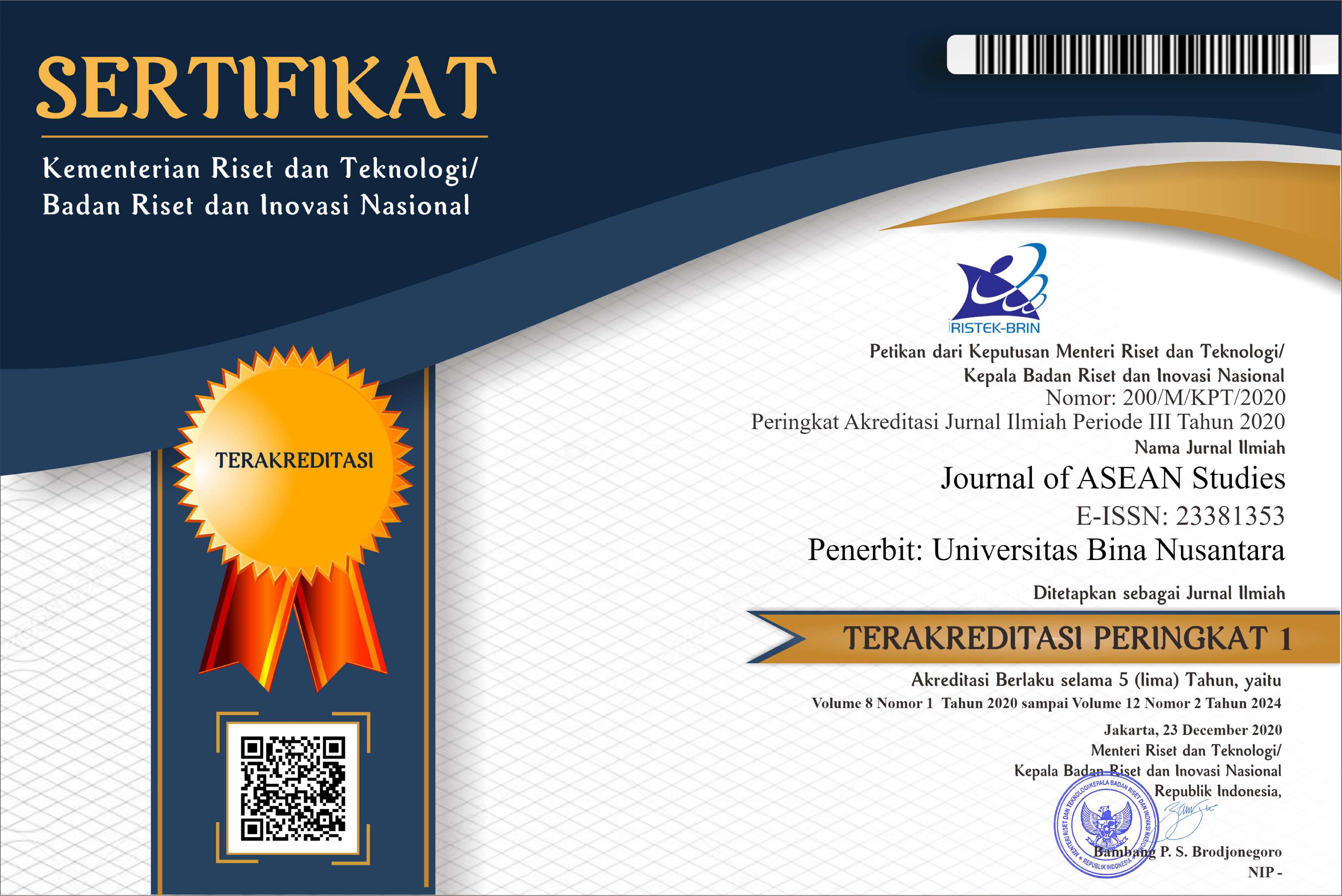China’s Crisis Bargaining in the South China Sea Dispute (2010-2013)
DOI:
https://doi.org/10.21512/jas.v2i2.302Keywords:
China, ASEAN, South China Sea Dispute, Crisis BargainingAbstract
As one of China’s most intricate territorial dispute, the South China Sea dispute has sufficiently consumed significant amount of Chinese leaders’ attention in Beijing. This paper reveals that China exerts signaling strategy in its crisis bargaining over the South China Sea dispute. This strategy contains reassurance as positive signal through offering negotiation and appearing self-restraint and of negative signal by means of escalatory acts and verbal threats. China’s crisis bargaining in the South China Sea dispute aims to preserve crisis stability: a stabilized condition after escalation in which neither further escalation nor near-distant resolution is in order. From the yearly basis analysis in the four-year span study, China’s longing for crisis stability fits into its conduct in crisis bargaining with Southeast Asian states.
Plum Analytics
References
An. (2011, July 14). China reiterates solving South China Sea disputes requires direct talks. Xinhua. Retrieved January 5, 2015, from http://news.xinhuanet.com/english2010/china/2011-07/14/c_13985652.htm
Ang, C. G. (2000). The South China Sea dispute revisited. Australian Journal of International Affairs, 54(2), 201-215.
Axelrod, R. (August, 1990). The concept of stability in the context of conventional war in Europe. Journal of Peace Research, 27(3), 247-254.
Bi, M. (2013, September 16). 6th senior officials’ meeting on implementation of DOC held in Suzhou. Xinhua. Retrieved February 11, 2014, from http://news.xinhuanet.com/english/video/2013-09/16/c_132723984.htm
Brams,S. J. & Kilgour, D. M. (September 1987). Threat escalation and crisis stability: A game-theoretic analysis. The American Political Science Review, 81(3), 833-850.
Buszynski, L. (December 2003). ASEAN, the Declaration on Conduct, and the South China Sea. Contemporary Southeast Asia: A Journal of International Strategic Affairs, 25(3), 343-362.
China, ASEAN begin discussion on stronger code of conduct: Chinese ambassador. (2010, September 30). China Daily online. Retrieved December 9, 2013, from http://www.chinadaily.com.cn/china/2010-09/30/content_11371512.htm
China opposes US statement on the South China Sea. (2012, August 5). China Daily Europe online. Retrieved December 12, 2013, from http://europe.chinadaily.com.cn/china/2012-08/05/content_ 15645062.htm
China opposes Vietnam claim to islands. (2012, June 21). China Daily USA online. Retrieved December 12, 2013, from http://usa.chinadaily.com.cn/china/2012-06/21/ content_15517679.htm
China summons Manila diplomat over Huangyan Island dispute. (2012, April 18). China Daily USA online. Retrieved December 12, 2013, from http://usa.chinadaily.com.cn/china/2012-04/18/content_15084482.htm
Emmers, R. (2010). The changing power distribution in the South China Sea: Implications for conflict management and avoidance. Political Science, 62(2), 118-131.
Fearon, J. D. (March 1998). Bargaining, enforcement, and international cooperation. International Organization, 52(2), 269-305.
Fearon, J. D. (February 1997). Signaling foreign policy interests: Tying hands versus sinking costs. Journal of Conflict Resolution, 41(1), 68-90.
Fearon, J. D. (June 1995). Rationalist explanations for war. International Organization, 49(3), 379-414.
Fravel, M. T. (2011). China’s strategy in the South China Sea. Contemporary Southeast Asia: A Journal of International and Strategic Affairs, 33(3), 292-319.
Fravel, M. T. (Winter 2007/2008). Power shifts and escalation: Explaining China’s use of force in territorial disputes. International Security, 32(3), 44-83.
Fravel, M. T. (Fall 2005). Regime insecurity and international cooperation: Explaining China’s compromises in territorial disputes. International Security, 30(2), 46-83.
Fu, P. (2013, September 10). China, ASEAN South China Sea meetings scheduled. Xinhua. Retrieved January 20, 2014, from http://news.xinhuanet.com/english/china/2013-09/10/c_132708803.htm
George, A. (2003). The need for influence theory and actor-specific behavioral models of adversaries. Comparative Strategy, 22(5), 463-487.
Goldstein, A. (Spring 2013). First things first: The pressing danger of crisis instability in U.S.-China relations. International Security, 37(4), 49-89.
Jerdén, B. (2014). The assertive China narrative: Why it is wrong and how so many still bought into it. The Chinese Journal of International Politics, 7(1), 47-88.
Jervis, R. (Winter 1991). Arms control, stability, and causes of war. Daedalus, 120(1), 167-181
Jervis, R. (1970). The logic of images in international relations. New Jersey: Princeton University Press.
Johnston, A. I. (Spring 2013). How new and assertive China is China’s new assertiveness. International Security, 37(4), 7-48.
Johnston, A. I. (March 1998). Militarized interstate dispute behaviour 1949-1992: A first cut at the data. The China Quarterly, 153, 1-30.
Johnston, A. I. (1996). Cultural realism and strategy in Maoist China. In P. J. Katzenstein (Ed.). The culture of national security: Norms and identity in world politics (pp. 216-268). New York: Columbia University Press.
Kim, J. (2010). Reassurance strategy: Incentives for use and conditions for success. Unpublished doctoral dissertation, Naval Postgraduate School.
Kydd, A. (Spring 2000). Trust, reassurance, and cooperation. International Organization, 54(2), 325-357.
Kydd, A. (1997). Sheep in sheep’s clothing: Why security seekers do not fight each other. Security Studies, 7(1), 114-155.
Langlois, J. P. (November 1991). Rational deterrence and crisis stability. American Journal of Political Science, 35(4), 801-832.
Li, M. (Winter 2010). Reconciling assertiveness and cooperation? China’s changing approach to the South China Sea Dispute. Security Challenges, 6(2), 49-68.
Li, X. & Zheng, Y. (2011, November 16). China seeks framework to resolve sea disputes. China Daily online. Retrieved November 28, 2013, from http://www.chinadaily.com.cn/cndy/2011-11/16/content_14101996.htm
Lebow, R. N. (2006). Reason divorced from reality: Thomas Schelling and strategic bargaining. International Politics, 43, 429-452.
Lebow, R. N. (Autumn 2001). Deterrence and reassurance: Lessons from the Cold War. Global Dialogue, 3(4), 119-132.
Lebow, R. N. & Stein, J. G. (1995). We all lost the Cold War. New Jersey: Princeton University Press.
Ministry of Foreign Affairs of the PRC. (2013, December 3). The evolving security situation in Asia and the role of China. Retrieved February 15, 2014, from http://www.fmprc.gov.cn/eng/wjdt/zyjh/t1105034.shtml
Ministry of Foreign Affairs of the PRC. (2013, January 4).
Spokesperson Hua Chunying’s regular press conference. Retrieved February 15, 2014, from http://www.fmprc.gov.cn/mfa_eng/xwfw_665399/s2510_665401/2511_665403/t1003086.shtml
Ministry of Foreign Affairs of the PRC. (2011, November 20). Premier Wen Jiabao elaborates China’s position on the South China Sea. Retrieved October 5, 2013, from http://www.fmprc.gov.cn/eng/topics/wjbdyldrhy/t879891.shtml
Ministry of Foreign Affairs of the PRC. (2011, November 1).
Spokesperson Hong Lei’s regular press conference. Retrieved November 10, 2013, from http://www.fmprc.gov.cn/eng/xwfw/s2510/2535/t873538.shtml
Ministry of Foreign Affairs of the PRC. (2011, May 28).
Spokesperson Jiang Yu’s remarks on China’s maritime law enforcement and surveillance on the South China Sea. Retrieved November 5, 2013, from http://www.fmprc.gov.cn/eng/xwfw/s2510/2535/t826601.shtml
Morrow, J. D. (June 1992). Signaling difficulties with linkage in crisis bargaining. International Studies Quarterly, 36(2), 153-172.
Morrow, J. D. (1989). Capabilities, uncertainty, and resolve: A limited model of crisis bargaining. American Journal of Political Science, 33(4), 941-972.
Mu, X. (2013, October 11). Chinese Premier calls for deepened cooperation in East Asia. Xinhua. Retrieved January 20, 2014, from http://news.xinhuanet.com/english/china/2013-10/11/ c_125510891.htm
Odgaard, L. (2003). The South China Sea: ASEAN’s security concerns about China. Security Dialogue, 34(1), 11-24.
Ortuoste, M. (2013). The Philippines in the South China Sea: Out of time, out of options? Southeast Asian Affairs, 240-253.
Powell, R. (2002). Bargaining theory and international conflict. Annual Review of Political Science, 5, 1-30.
Powell, R. (March 1989). Crisis stability in the nuclear age. The American Political Science Review, 83(1), 61-76.
Rowan, J. P. (May/June 2005). The U.S.-Japan security alliance, ASEAN, and the South China Sea dispute. Asian Survey, 45(3), 414-436.
Scobell, A. (2003). China’s use of military force: Beyond the great wall and the long march. Cambridge, UK: Cambridge University Press.
Stein, J. G. (2013). Threat perception in international relations. In L. Huddy, D. O. Sears, & J. S. Levy (Eds.), The Oxford handbook of political psychology (2nd ed.). New York: Oxford University Press.
Stein, J. G. (Autumn 1991). Reassurance in international conflict management. Political Science Quarterly, 106(3), 431-451.
Storey, I. J. (December 2010). China’s missteps in Southeast Asia: Less charm, more offensive. China Brief: a Journal of Analysis and Information, X(25), 4-7, Retrieved October 30, 2013, from http://www.jamestown.org/uploads/media/cb_010_3d52c6.pdf
Storey, I. J. (April 1999). Creeping assertiveness: China, the Philippines and the South China Sea dispute. Contemporary Southeast Asia, 21(1), 95-118.
Sun, X. & Huang, Y. (December 2012). Revisiting China’s use of force in Asia: Dynamic, level and beyond. Pacific Focus, 27(3), 393-420.
Thao, N. H. (2001). Vietnam and the Code of Conduct for the South China Sea. Ocean Development & International Law, 32(2), 105-130.
Thayer, C. A. (2013). ASEAN, China and the code of conduct in the South China Sea. SAIS Review of International Affairs, 33(2), 75-84.
Thayer, C. A. (December 2011). China’s new wave of aggressive assertiveness in the South China Sea. International Journal of China Studies, 2(3), 555-583.
Tretiak, D. (1979). Vietnam war and its consequences. The China Quarterly, 80 (1979), 740-767.
Wang, G. (2011, November 18). Full text of Chinese Premier Wen’s statement at 14th China-ASEAN Summit. Xinhua. Retrieved November 28, 2013, from http://news.xinhuanet.com/english2010/china/2011-11/18/c_ 131255936_2.htm
Yahuda, M. (2013). China’s new assertiveness in the South China Sea. Journal of Contemporary China, 22, 446-459.
Yan. (2013, September 4). Premier Li Keqiang’s keynote speech at 10th China-ASEAN Expo. Xinhua. Retrieved January 23, 2014, from http://news.xinhuanet.com/english/china/2013-09/04/c_132688764.htm
Yan. (2012, July 13). Mutual trust, cooperation essential to formulation of COC: Chinese FM. Xinhua. Retrieved December 12, 2013, from http://news.xinhuanet.com/english/china/2012-07/13/c_131712152.htm
Zartman, I. W. (2001). The timing of peace initiatives: Hurting stalemates and ripe moments. The Global Review of Ethnopolitics, 1(1): 8-18.
Zhang, X. (2005). China’s 1979 war with Vietnam: A reassessment. The China Quarterly, 184, 851-874.
Zhang, Y. & Qiu, Q. (2012, April 19). Manila’s attempt to internationalize dispute. China Daily USA online. Retrieved December 12, 2013, from http://usa.chinadaily.com.cn/china/2012-04/19/content_15084620.htm



















